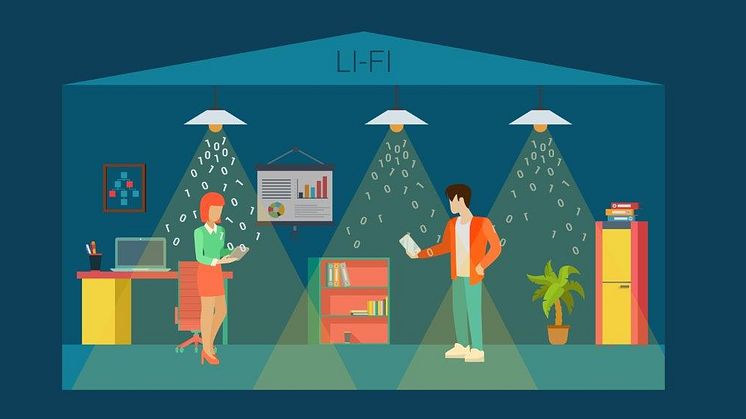
Press release -
Optical wireless technologies research set to change the future of communication
Academics from Northumbria University have been awarded almost £850,000 for three research projects which could transform how we communicate in the future.
With funding awarded from a prestigious European doctoral training and research programme, the Engineering and Physical Sciences Research Council (EPSRC) and the Department for Science, Innovation and Technology, members of Northumbria’s Optical Communications Research Group will be advancing current understanding of optical wireless communications.
Academics from the University are part of two successful bids for funding from Horizon Europe’s Marie Skłodowska-Curie Actions (MSCA) scheme – a European Commission programme which funds innovative research and provides opportunities for up-and-coming academics.
The first project aims to provide internet connection to parts of the world currently lacking broadband through a new system which uses lasers to transport data between the earth and satellites and vice versa.
The project, named Free-space Optical Communications for Aerial-satellite Networks (FOCAL), will provide an alternative to ground-based radio and fibre connection, and radio frequency-based satellite communications systems.
The Northumbria research team comprises of Dr Juna Sathian and Dr Xicong Li, led by the project’s principal investigator Professor Zabih Ghassemlooy, who explains: “There are currently three billion people around the world who do not have access to broadband due to a lack of ground-based infrastructure.
“Unfortunately, radio frequency-based satellite systems are now also nearing their capacity limits and cannot be scaled further so an alternative is needed to ensure everyone has access to fast, secure internet connection in future.
“Free-space optical technology, using lasers to transport data quickly via satellites, provides a solution – it delivers greater capacity far more securely.
“However, this is still very new technology, so the FOCAL project aims to develop our understanding and overcome current challenges so it can be expanded and developed to become a new communication backbone in the sky.”
The second MSCA-funded project Northumbria is part of involves creating a 6G light-based communication system which would allow data to be sent to mobile phones, and other internet-connected devices, through LED lights.
The Optical and Wireless Sensors Networks for 6G scenarios (OWIN6G) project could be used for tracking and positioning, for example in manufacturing environments.
Also led by Professor Ghassemlooy, the project team includes Northumbria academics Dr Qiang Wu, and Dr Yongtao Qu.
As Professor Ghassemlooy explains: “This technology allows us to convert data into light signals using LED lights. The lightbulbs send coded information and the camera in smart phones and smart devices acts like a receiver, extracting that information and displaying it as a message on the screen.
“So many of us already have smart phones and the data could be sent through the lighting systems already used in so many buildings, so from a sustainability perspective this technology would have very little environmental impact or waste.
“It is also incredibly secure as light from the LEDs is confined to one area so isn’t susceptible to hacking.”
The technology could be used in a variety of ways – for example, to share information at train and bus stations or airports, with users simply having to point their phone camera at the nearest LED light to receive up-to-date information about travel times.
It could also be used for tracking purposes, for example in factories and warehouses which need to track products, or as part of an assembly line.
The three-year FOCAL project is led by Ecole Centrale Méditerranée, in France, with each of the 15 partners involved, including Northumbria, recruiting one doctoral student and leading on a specific element of the research.
The OWIN6G project is led by the Czech Technical University in Prague with 10 partners (seven academic and three industry). Northumbria University has been awarded one doctoral candidate, with another awarded to industry partner IST Ltd, who will also be registered for their PhD at Northumbria.
Northumbria has been awarded over £600,000 between both projects with academics working on the development of ‘software defined networks for transmitters and receivers’ for the FOCAL project; and all optical sensor node for data transmission and with energy harvesting capability for the OWIN6G project.
Over the last 25 years Northumbria’s Optical Communications Research Group (OCRG) has developed world-leading expertise in free-space laser communications and visible light communications research, building up an international reputation for their pioneering work in these fields.
In addition to the two MSCA projects, the OCRG has also recently been awarded £276,000 through the TITAN project – one of three ‘future telecoms hubs’ funded through the Engineering and Physical Sciences Research Council (EPSRC) and the Department for Science, Innovation and Technology.
TITAN provides a platform for research collaboration and engagement across academic, industrial and governmental partners, with the aim of conducting transformative research to create new communication networks for the future.
Northumbria are leading the Integrated Sensing, Localisation, and Communication for 6G based on AI-Assisted Optical Camera Communication (6GISLOC) project, which aims to develop optical wireless communication systems for use in 6G networks, using existing lighting and wireless infrastructures.
Professor Ghassemlooy is the project’s principal investigator, with Dr Xicong Li and Dr Juna Sathian of Northumbria’s Photonics Technology Laboratory also involved.
Professor Ghassemlooy said: “The main aim of the project is to develop a prototype system that uses multiple LED light sources and a camera for sensing, localisation and communication in indoor environments.”
Find out more about Northumbria University’s Optical Communications Research Group and the Department of Mathematics, Physics and Electrical Engineering.
Topics
Categories
UNIVERSITY OF THE YEAR 2022 (Times Higher Education Awards)
Northumbria is a research-intensive university that unlocks potential for all, changing lives regionally, nationally and internationally.
Two thirds of Northumbria's undergraduate students come from the North East region and go into employment in the region when they graduate, demonstrating Northumbria's significant contribution to social mobility and levelling up in the North East of England.
Find out more about us at www.northumbria.ac.uk
--- Please contact media.communications@northumbria.ac.uk with any media enquiries or interview requests ---











